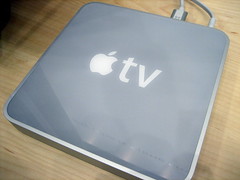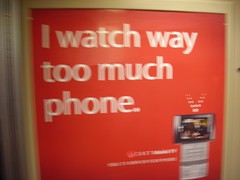This evening our family discussed a movie at the dinner table, and since we ate early, I decided to check if the title was available on Netflix for “instant viewing.” Since we are Netflix subscribers, it doesn’t cost us anything extra to watch videos (about 18 hours per month) streamed live off the website. Lo and behold, the title we had discussed was available in streaming form, so just a few minutes after talking about a movie (which the kids hadn’t seen) we were watching the film in its entirety on our television. No trip to the video store, and no waiting for the Netflix DVD to arrive in the mail. Literally video on demand.
After watching the movie, since I had a laptop connected to the television and I hadn’t tried this before, we watched a couple of Kevin Honeycutt’s “Driving Questions” video podcasts on the TV in iTunes. My two oldest kids met Kevin most recently when he and his son gave us a tour of their backyard treehouse, so they thought it was SO COOL to see him “on television!” My 7 year old was very interested in how Kevin created his podcast in the car, and was amazed that he was just using a laptop with a built-in iSight camera (like our Macbook) to make them.
Kevin’s ideas in his podcasts are great too, btw. We watched the episode “My friend Phil died but using technology, we resurrected him!” about how he’s converted an old console radio into a 21st century computerized jukebox, and “Classic-rock inspired thinking.” In the latter episode, Kevin discusses how important music and the entire EXPERIENCE of learning is to the “stickiness” of the ideas a person retains years afterward. I agree with his point that we should be very intentional about the EXPERIENCE we try to shape for learners, if we are really interested in learning and retention of ideas.
We don’t have an Apple TV in our house yet, and it is an unusual thing to have a laptop computer connected to our television. (To date, I’d say we’ve done this less than five times (total) since we moved to Oklahoma a year ago.) In the future, however, I am certain it will NOT be unusual to have a device connected to our television which is also connected to the Internet. Seeing “our friends” (like we saw Kevin tonight) “on TV” is going to be commonplace, not rare, in the not too distant future. As I wrote in June in the post “Prepare now for the 10,000+ channel future,” some people are predicting that within 5-10 years all teenagers are going to be watching more video programs (call them podcasts, Internet TV shows, or whatever you want) created by their peers for entertainment than they will watch “primetime television.” Digital video recorders are helping move us into an era when “primetime” has much less meaning, as well as commercial value, when it comes to consuming (watching) video content. YouTube and other online video sites, like Blip.tv, are also major contributors to this trend. I think we caught a very tangible glimpse of this “future world” this evening in our Oklahoma living room.
One side aspect of this multi-channel future which we might not discuss or reflect on often enough is the fact that for most households, access to this world of 10,000+ video streams will be unfiltered. Yes, as Walt Mossberg pointed out in his June article, “You Have Weapons In Your Computer To Monitor Your Kids,” Windows Vista as well as Macintosh OS X have built-in parental controls for content filtering. But how about cell phones? The iPhone does not presently offer any parental controls. (I have to be careful when my kids are using it and click the YouTube video button.) It seems doubtful many other cell phones, which will increasingly be streaming videos from the web in the not-too distant future, will offer any.
Are we doing an adequate job in our homes, schools, churches, and communities preparing students to BE THE FILTER when it comes to their own consumption of digital media? Are we working to create cultures of accountability where people of all ages know they are responsible for everywhere they visit on the television as well as the Internet, as well as the media they choose to consume and expose their eyes and mind to? I think we have a lot of work to do in this area. John Rice’s summer TechEdge article, “Fooling the Filter: How Students Bypass Content Control Software” (PDF) provides a current overview of many ways students are bypassing content filters (and accountability systems) now in schools, homes, and other locations where they can get online. Blocking sites is, by itself, an insufficient response to the offensive and inappropriate content now available on the web. I’m convinced we need to engage in more conversations (“digital dialog”) about WHY we choose (and should choose) not to view or consume certain types of materials, and how we can make each other accountable on an ongoing basis for the choices we make as digital content consumers. This is not just a need for kids, as adults we need accountability too.
The future of television (and more generally “video media”) is exciting, but it is also scary. Whatever our perceptions of the changing information landscape might be, the fact is, the landscape is changing fast. Our need for ongoing digital dialog will persist.
Technorati Tags:
television, primetime, appletv, podcasting, podcast, future, tv
If you enjoyed this post and found it useful, subscribe to Wes’ free newsletter. Check out Wes’ video tutorial library, “Playing with Media.” Information about more ways to learn with Dr. Wesley Fryer are available on wesfryer.com/after.
On this day..
- Contrasting Video Messages: Goodnight iPad and Cheryl and Morgan: Learning Independence – 2013
- Professionally Mobilize Your WordPress Blog with PluginBuddy Mobile – 2012
- The Hobbit in Five Minutes [Video] – 2011
- Look for innovations which change the script – 2010
- A delicious facelift, skypecast drawbacks, and a new Flickr site – 2008
- Drupal versus Ning for Learning Community Websites – 2008
- links for 2008-07-31 – 2008
- Drupal dabbling begins – 2008
- Whitelisting websites – what a pain! – 2007
- Quick iTunes Backup – 2007



Comments
2 responses to “Glimpsing the future of television”
Wes,
You raised one of my favorite issues – one I’ve been responding to for more than a quarter century – filtering TV.
My parents subscribed to cable television and Home Box Office (HBO) when I was in the 5th grade. If I had to guess, it was January 1974, but could have been ’73. Yes, we must have been the 3rd house in the world with HBO. I remember that “The Sting” was one of the first major motion pictures we watched. (According to Wikipedia, HBO started in 1972 and we likely subscribed in January 1974). My mother’s family had a television in 1946 or ’47.
The reason this is relevant is that both of my parents worked and my sister (a year younger) and I were “latch-key” children – wahhh! Despite having Cable TV in the house and parents away, my sister and I were not damaged by access to inappropriate content. That’s because my parents told us not to watch inappropriate shows and we largely obeyed them. Imagine that.
We had an open loving trusting relationship in which at the very least we wished to avoid my mother yelling at us or being disappointed, so we behaved.
No V-Chip, Tipper Gore or white-listing required.
Gary, I think your story is a good object lesson for the view I support. Technology cannot “save us” in filtering TV or the Internet. We need more digital dialog. It is reasonable, however, to have a level of filtering in both our schools as well as our homes. The Internet is NOT HBO. There are virtually no limits to the depths of depravity now accessible and viewable online. It is unfortunate people are putting so much trash online, but it is also unfortunate many adults seem willing to keep blaming the Internet for the garbage instead of holding individuals responsible for the choices they make online. It sounds like you and your sister were accountable to each other, as well as your parents, for the HBO and other television programs you chose to watch at home. We need similar accountability systems in our schools and homes. Some of these may involve technology, but many won’t and shouldn’t. This comes down to good parenting and good communication patterns. This is an example of how I think a challenge (the need for awareness and accountability for online behavior) can be turned into an opportunity, for schools as well as families.